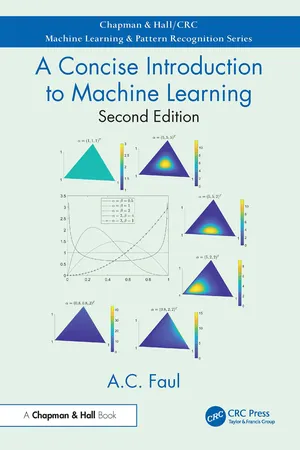
- 334 pages
- English
- ePUB (mobile friendly)
- Available on iOS & Android
A Concise Introduction to Machine Learning
About this book
A Concise Introduction to Machine Learning uses mathematics as the common language to explain a variety of machine learning concepts from basic principles and illustrates every concept using examples in both Python and MATLAB®, which are available on GitHub and can be run from there in Binder in a web browser. Each chapter concludes with exercises to explore the content.
The emphasis of the book is on the question of Why—only if "why" an algorithm is successful is understood, can it be properly applied and the results trusted. Standard techniques are treated rigorously, including an introduction to the necessary probability theory. This book addresses the commonalities of methods, aims to give a thorough and in-depth treatment and develop intuition for the inner workings of algorithms, while remaining concise.
This useful reference should be essential on the bookshelf of anyone employing machine learning techniques, since it is born out of strong experience in university teaching and research on algorithms, while remaining approachable and readable.
Frequently asked questions
- Essential is ideal for learners and professionals who enjoy exploring a wide range of subjects. Access the Essential Library with 800,000+ trusted titles and best-sellers across business, personal growth, and the humanities. Includes unlimited reading time and Standard Read Aloud voice.
- Complete: Perfect for advanced learners and researchers needing full, unrestricted access. Unlock 1.4M+ books across hundreds of subjects, including academic and specialized titles. The Complete Plan also includes advanced features like Premium Read Aloud and Research Assistant.
Please note we cannot support devices running on iOS 13 and Android 7 or earlier. Learn more about using the app.
Information
Table of contents
- Cover Page
- Endorsements Page
- Half-Title Page
- Series Page
- Title Page
- Copyright Page
- Dedication Page
- Contents
- List of Figures
- List of Listings
- Foreword
- Preface
- Acknowledgments
- Chapter 1 Introduction
- Chapter 2 Probability Theory
- Chapter 3 Sampling
- Chapter 4 Linear Classification
- Chapter 5 Non-Linear Classification
- Chapter 6 Clustering
- Chapter 7 Dimensionality Reduction
- Chapter 8 Regression
- Chapter 9 Feature Learning
- Appendix A Matrix Formulae
- Index